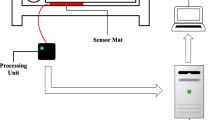Abstract
The individual experience of inadequate or insufficient sleep is one of the most common health issues in the industrialized world. The 65% of Italian population reports disturbed sleep experiences, while chronic sleep disorders affect about 10% of the population. The people with inadequate and unsatisfactory sleep often suffers drowsiness during the day associated with both somatic and mental disorders. For these reasons, the systematic and continuative monitoring of sleep is one of the main objectives in preventive, personalized and participatory sleep medicine. The purpose of this paper is to describe the architecture of a “smart mattress’’ (SmartBed) that is the main outcome of the Italian R&D project called LAID. SmartBed will be able to non-obtrusively collect physiological and environmental parameters and signals, to processing them and to provide information about the quality of sleep, the levels of stress, and more generally the well-being of an individual. Specifically, SmartBed will be able to estimate data relating to cardiorespiratory activity, movements, body position, snoring and environmental parameters. SmartBed aims to obtain a continuative and ecological assessment of sleep and well-being of a person, in order to improve his quality of life. SmartBed will be a fundamental tool for carrying out both longitudinal and epidemiological studies on the quality of sleep and life on general population.
Access this chapter
Tax calculation will be finalised at checkout
Purchases are for personal use only
Similar content being viewed by others
References
Terzano, M.G., et al.: Studio Morfeo: insomnia in primary care, a survey conducted on the Italian population. Sleep Med. 5(1), 67–75 (2004)
Leger, D., Guilleminault, C., Bader, G., Levy, E., Paillard, M.: Medical and socio-professional impact of insomnia. Sleep 25(6), 625–629 (2002)
Hao, J., Jayachandran, M., Kng, P.L., Foo, S.F., Aung, P.W.A., Cai, Z.: FBG-based smart bed system for healthcare applications. Front. Optoelectron. China 3(1), 78–83 (2010). https://doi.org/10.1007/s12200-009-0066-0
Cheng, J., Sundholm, M., Zhou, B., Hirsch, M., Lukowicz, P.: Smart-surface: large scale textile pressure sensors arrays for activity recognition. Pervasive Mob. Comput. 30, 97–112 (2016)
Zhou, B., Lukowicz, P.: Textile pressure force mapping. In: Schneegass, S., Amft, O. (eds.) Smart Textiles, pp. 31–47. Springer, Cham (2017). https://doi.org/10.1007/978-3-319-50124-6_3
Marquis-Favre, C., Premat, E., Aubree, D.: Noise and its effects - a review on qualitative aspects of sound. Part II: noise and annoyance. Acta Acustica United Acustica 91(4), 626–642 (2005)
Ohrstrom, E., Skanberg, A.: Sleep disturbances from road traffic and ventilation noise - laboratory and field experiments. J. Sound Vib. 271(1–2), 279–296 (2004)
Bonnet, M.H., Arand, D.L.: The impact of music upon sleep tendency as measured by the multiple sleep latency test and maintenance of wakefulness test. Physiol. Behav. 71(5), 485–492 (2000)
Okamoto-Mizuno, K., Tsuzuki, K., Mizuno, K., Iwaki, T.: Effects of partial humid heat exposure during different segments of sleep on human sleep stages and body temperature. Physiol. Behav. 83(5), 759–765 (2005)
Wickens, K., et al.: The determinants of dust mite allergen and its relationship to the prevalence of symptoms of asthma in the Asia-Pacific region. Pediatr. Allergy Immunol. 15(1), 55–61 (2004)
Berglund, B., Lindvall, T.: Community noise: Center for Sensory Research. Stockholm University and Karolinska Institute (1995)
Libert, J.P., Dinisi, J., Fukuda, H., Muzet, A., Ehrhart, J., Amoros, C.: Effect of continuous heat exposure on sleep stages in humans. Sleep 11(2), 195–209 (1988)
Dewasmes, G., Telliez, F., Muzet, A.: Effects of a nocturnal environment perceived as warm on subsequent daytime sleep in humans. Sleep 23(3), 409–413 (2000)
Vehkaoja, A., Rajala, S., Kumpulainen, P., Lekkala, J.: Correlation approach for the detection of the heartbeat intervals using force sensors placed under the bed posts. J. Med. Eng. Technol. 37(5), 327–333 (2013)
Brueser, C., Winter, S., Leonhardt, S.: Robust inter-beat interval estimation in cardiac vibration signals. Physiol. Meas. 34(2), 123–138 (2013)
Choe, S.-T., Cho, W.-D.: Simplified real-time heartbeat detection in ballistocardiography using a dispersion-maximum method. Biomed. Res. India 28(9), 3974–3985 (2017)
Sanchez Morillo, D., Rojas Ojeda, J.L., Crespo Foix, L.F., Leon Jimenez, A.: An accelerometer-based device for sleep apnea screening. IEEE Trans. Inf. Technol. Biomed. 14(2), 491–499 (2010)
Nam, Y., Kim, Y., Lee, J.: Sleep monitoring based on a tri-axial accelerometer and a pressure Sensor. Sensors. 16(5), 750 (2016)
Ren, Y., Wang, C., Yang, J., Chen, Y.: IEEE fine-grained sleep monitoring: hearing your breathing with smartphones. In: 2015 IEEE Conference on Computer Communications (Infocom) (2015)
Acknowledgment
LAID project is co-funded by Tuscany POR FESR 2014−2020 (DD 3389/2014 call 1). We would to thank all our industrial partners: Materassificio Montalese S.P.A, EB Neuro S.P.A and BP Engineering S.P.A.
Author information
Authors and Affiliations
Corresponding author
Editor information
Editors and Affiliations
Rights and permissions
Copyright information
© 2020 ICST Institute for Computer Sciences, Social Informatics and Telecommunications Engineering
About this paper
Cite this paper
Laurino, M., Carbonaro, N., Menicucci, D., Alfì, G., Gemignani, A., Tognetti, A. (2020). A SmartBed for Non-obtrusive Physiological Monitoring During Sleep: The LAID Project. In: O'Hare, G., O'Grady, M., O’Donoghue, J., Henn, P. (eds) Wireless Mobile Communication and Healthcare. MobiHealth 2019. Lecture Notes of the Institute for Computer Sciences, Social Informatics and Telecommunications Engineering, vol 320. Springer, Cham. https://doi.org/10.1007/978-3-030-49289-2_12
Download citation
DOI: https://doi.org/10.1007/978-3-030-49289-2_12
Published:
Publisher Name: Springer, Cham
Print ISBN: 978-3-030-49288-5
Online ISBN: 978-3-030-49289-2
eBook Packages: Computer ScienceComputer Science (R0)




